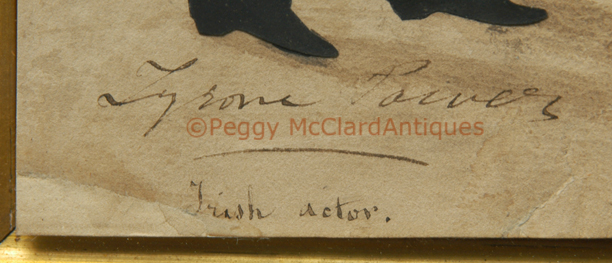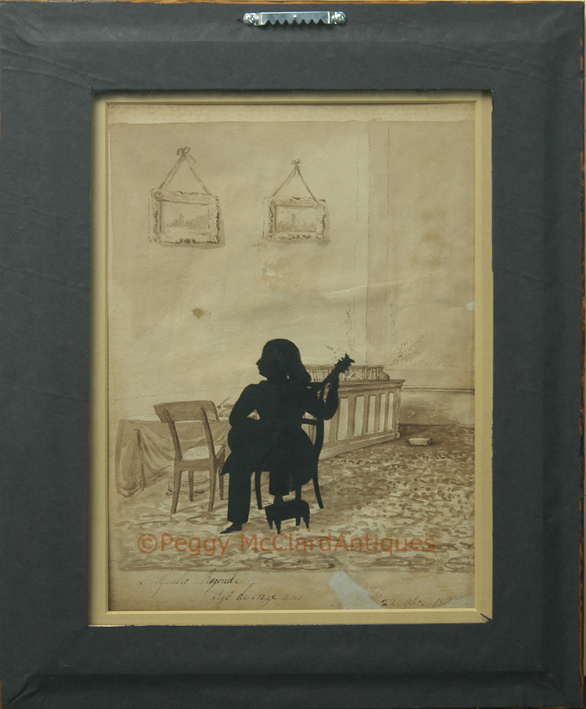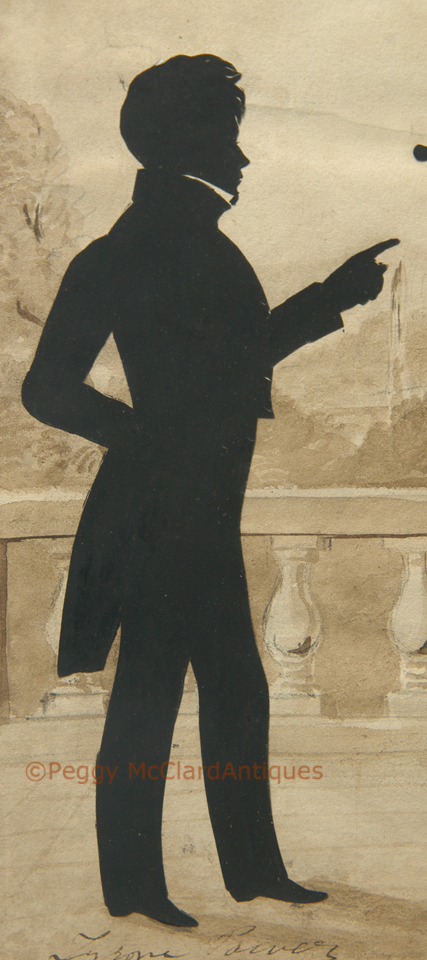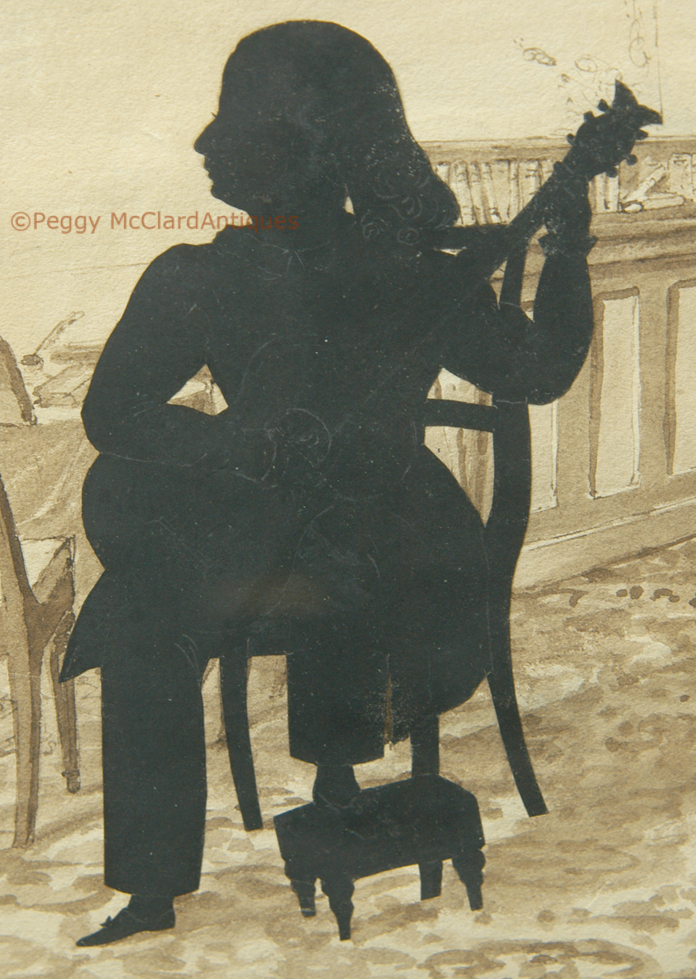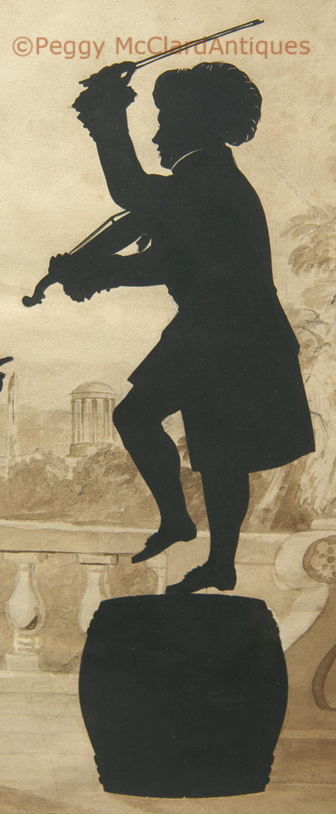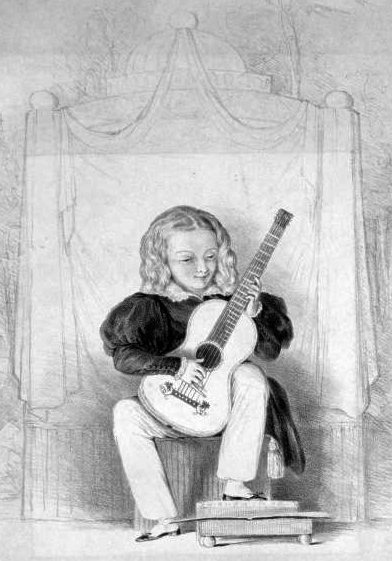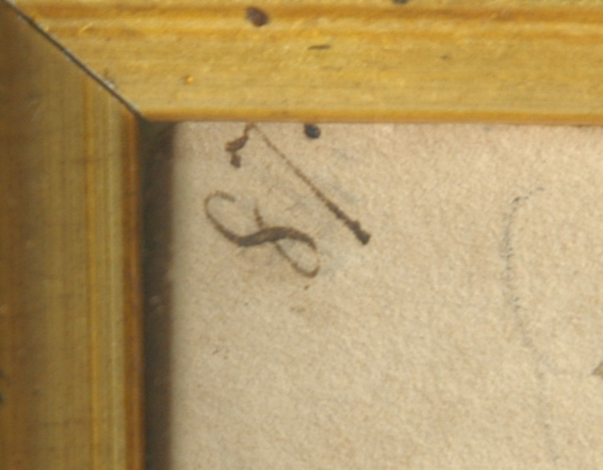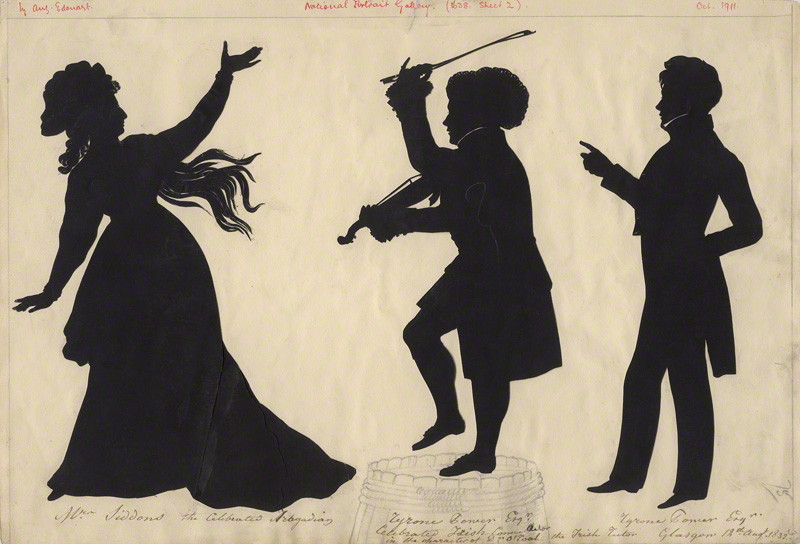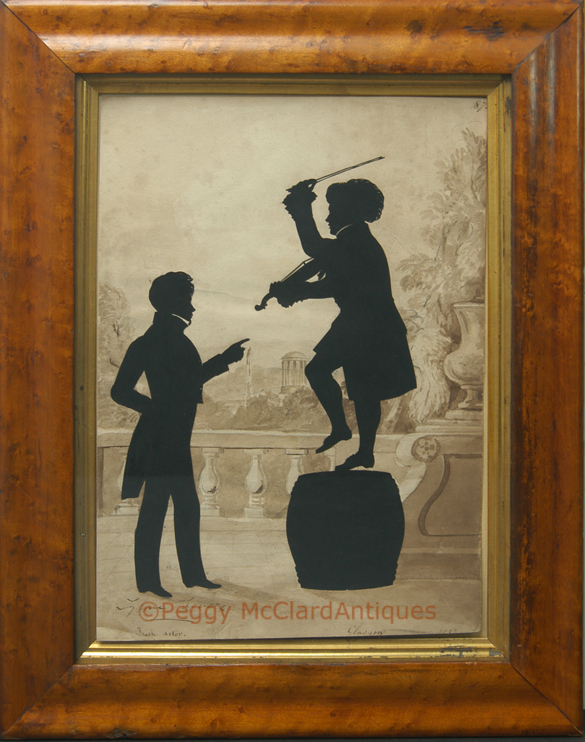
I am so pleased to offer 4 of what I consider ground-breaking silhouettes from one of Edouart’s “finished” folios. In 1923 a folio was sold by E.F. Bonaventure Inc, of New York to Miss Sarah C. Hewitt and referred to as “1 Vol. Silhouettes of eminent Americans by Edouart.” Bonaventure supposedly acquired the folio in Paris, but no clear records support that. The American folio includes single-sided pages of lithograph or watercolor backgrounds on which Edouart pasted figures of important Americans. Within that folio, Edouart had most of his sitters autograph the background on which the figure was pasted. He also usually included the date and place of titles along with descriptive titles of the sitters. The American folio is in the collection of the National Portrait Gallery in Washington DC. and is the focus on Auguste Edouart’s Silhouettes of Eminent Americans 1839 1844, Andrew Oliver, Published for the National Portrait Gallery, Smithsonian Institution by the University Press of Virginia, Charlottesville, 1977. Recently, another finished folio came up for auction. It contained important Irish figures--all subjects in the folio were men. The backgrounds were mostly lithographs with a few watercolor backgrounds. An 1838 advertisement by Edouart refers to “His Belfast Book of Public Characters”. Among other things, the ad reads, "His Belfast Book of Public Characters is likewise very interesting, by the correct delineations of the features, attitudes, and natural expression of our most distinguished personables who have honoured him with a sitting." Belfast News-Letter, Friday 23 November 1838. It seems clear that Edouart kept fully finished folios of distinguished citizens of places that he visited for marketing reasons. What better way to market your abilities as an artist than to present stunning folios gathering the most important people who have sat for you and presenting them on fully furnished backgrounds? These folios must have been very impressive to the people who flocked to Edouart’s arranged galleries throughout the British Isles and America.
Now, these four double-sided silhouettes with watercolor backgrounds indicate another “finished” folio by Edouart. Unfortunately, at this time, the only provenance we have for these silhouettes prior to 2014 is that the came from a private collection and had previously been purchased from David Ker Fine Art in London, probably during the 1980s. They came to me very recently from England and do not appear to have ever been framed. With the exception of the page with Sarah Hamilton, each page has Edouart’s page number written into one corner. (Apparently, Hamilton’s page number was previously cut off although the reverse of that page still contains its page number.) The pages are not all evenly cut and some of the writing is so close to the paper’s edge that it appears that the pages have been cut just a little. Considering the paper size of the recently offered Irish folio at Sotheby’s, each page is an appropriate size, which indicates that only slight edges have been cut. They came unframed and I had them framed in period bird’s-eye maple frames of similar (but not exact) profiles and similar (but not exact) profile period gilt liners. Early glass has been placed on the front and back of each silhouette. The pages are held in place between two pieces of acid-free ragboard, very lightly held with tiny dots of acid-free rice starch. Every effort was made to allow all writing and page numbers to remain visible. Unfortunately, in most cases, the page numbers had to necessarily be covered to avoid covering some of the more important inscriptions at the bottom of the pages. As will be noted in the individual listings, the very bottom edges of some of the pages is loose between the envelope of ragboard. This was necessary to allow the inscriptions to show but does allow the very bottom of the paper to swing freely when the silhouette is not stored in an upright position. I tell you this because there is a slight possibility that, during shipping, the very tiny amount of the top of the silhouette paper may pull loose from the top hinge of the ragboard frame and will require a trip to a good framer to open the frame and replace the paper between the ragboard with good conservation materials (i.e. rice starch). Some of the pages have very lightly penciled collection numbers in corners. Framed sizes are ever so slightly different because variables surrounding the effort made to show as much of each sheet of paper as possible and slight variations in sizes of the sheets of paper (which are each approximately 13 ½” x 10”).
In America, we know the name Tyrone Power as an American screen actor of the 1930s through 1950s. (I find it amusing that my mother was absolutely in love with Tyrone Power of the American silver screen!) I offer you our Tyrone’s great-grandfather, Tyrone Power! Tyrone Power was an actor, comedian, theatre manager and author, David Powell (1781-1841) being his real name. He is generally listed as an “Irish actor” but an 1838 account of him gives the actual birthplace of “dainty little Davy” as Glamorganshire County in Wales. This same account says that Power worked on losing his Welsh accent for the stage with “a few glasses of whiskey” but “while daily losing his native Welsh, he picked up too much of his tutor’s native Irish, to which he added an occasional sprinkling of Newcastle burr, till it became the most unaccountable mixture that was ever inflicted on any audience in the three kingdoms.” Although he later disliked taking on an Irish accent, his brogue fooled even the most English of his audiences and he became “the best actor of the low Irish characters at present on the boards…”1
One account says the first Tyrone made his debut on the stage in 1815. Although he would have been 34 at his debut, he is repeatedly referred to as “a broth of a boy.” He must have displayed an eternal youth. He was known for his comic Irish parts, as it was written many times that “he cannot portray the gentleman.” He also wrote and appeared in his own comedies, including St. Patrick’s Eve (1832), and O’Flannigan and the Fairies (1836). Power and a servant drowned while returning to Ireland from his third tour of America on the boat SS President when the ship sank in 1841.
Edouart’s glorious silhouette shows the actor Tyrone Power standing to the viewer’s left pointing at a second profile of himself in the character of Dr. O'Toole playing the fiddle in “The Irish Tutor”. Inscribed along the bottom “Tyrone Power” (this appears to be the sitter's autograph), “Irish actor Glasgow 1832”. The inscription for the name does not appear to be Edouart’s writing and is likely Power’s autograph. Found tucked inside with this silhouette are two newspaper clippings, one a memoir that claims he was Welsh and not Irish and the second (annotated in Edouart's hand) an account of the shipwreck in which the actor and his servant perished in 1841.
The duplicate folio version of this profile (in mirror image with an
additional figure and the barrel in pencil outline only) was purchased
from Mrs. Jackson by the National Portrait Gallery and can be seen on
their website
http://www.npg.org.uk/collections/search/portraitLarge/mw38216/Sarah-Siddons-ne-Kemble-Tyrone-Power-as-Dr-OToole-in-The-Irish-Tutor-Tyrone-Power?LinkID=mp57445&search=sas&sText=tyrone+power&OConly=true&role=sit&rNo=1[1]
The reverse side is a second profile of Italian classical guitarist, composer and child prodigy Guilio Regondi seated in an interior. Regondi is recorded in history as a principal figure of the guitar in the Romantic period. He was born in Geneva in either 1822 or 1824. His father Guiseppe was from Milan, Italy and his mother was German. He made his debut as a child prodigy in Lyons, France at 8 years old (assuming the 1822 birth year). In Paris he became instantly famous and had many bookings to play in the best concert halls. In 1831, he moved to London with his family. His recognition continued with many positive reviews of the magazine. About 1835, Regondi took an interest in a new melodic wind instrument, the concertina and became a skilled performer with this instrument also. In 1840-41, he toured Europe with the cellist Joseph Ledel. After 1850, it appears that Regondi devoted his music solely to the concertina, for which he published some work. He composed and left only five works for the solo guitar, all of which are of great value to the history of Romantic guitar. He continued his concert touring until 1860 and died in London in 1872. Guilio appeared in London in 1831 that is the year of this profile. The inscription is partially obscured but what I can read is “Guilio Regondi / Agé de onze ans … 22 … 1831.” Since either his given birth years would put him at most nine years old in 1831, it looks as if Edouart may have got his age wrong!
Edouart depicted him sitting towards the viewer at a bit of a three-quarter angle with his head turned in profile. He wears his long wavy hair in a ponytail. His foot rests on a cricket stool. He plays his guitar in an interior room, sitting next to a tablet-backed chair which faces a covered pedestal table on which writing instruments sit. To the right background, sits what appears to be a half-cupboard with a book shelf on top. The walls have decorative painting in the corners and the floor covering is heavily patterned. The most unusual thing about this profile though is that Edouart has added substantial fine detail to the body of the figure not in pencil as we see during his later American years but in what appears to me to be Chinese white. The guitar would not be visible but for the embellishment. The background painting for this page does not reach to the very edges of the paper as it does in the other silhouettes of this group. There are three areas that show a bit of scrubbing, including the bottom edge at about 5 o’clock where part of the inscription is lost. The Regondi duplicate is not noted in Mrs. Jackson’s book, confirming that the folio from which these silhouettes came was not in Mrs. Jackson’s possession when she wrote the book.
The Power silhouette has Edouart’s handwritten page number “87” in the upper left corner and the Regondi silhouette has the handwritten page number “88” in the upper right corner (although the Regondi page number is mostly hidden by the frame.
The background paper for both sides of the silhouette has toned to a
wonderful sepia color that, I believe, helps set the sepia watercolor
work. Framed size is 18 ½” x 15”.
(#5575) POR
References for the silhouettes:
Jackson, Mrs. F. Nevil, Ancestors in Silhouette by August Edouart, The Bodley Head, London; John Lane Co., New York, 1921. 160. (Noted as 2 portraits of Power and that the duplicate page was sold to the National Portrait Gallery, London. This notation is for the duplicate, mirror image of the offered silhouette.)
The folio duplicate may be seen at the National Portrait
Gallery, London website at
http://www.npg.org.uk/collections/search/portraitLarge/mw38216/Sarah-Siddons-ne-Kemble-Tyrone-Power-as-Dr-OToole-in-The-Irish-Tutor-Tyrone-Power?LinkID=mp57445&search=sas&sText=tyrone+power&OConly=true&role=sit&rNo=1[1]
References for Tyrone Power:
Maude, Cyril, The Haymarket Theatre: Some Records & Reminisces, E.P. Dutton, New York & Grant Richards, 48 Leicester Square, 1903. 119-20.
“Our Actors”, The Metropolitan Magazine, Vol. XVII, September to December, 1836, Saunders & Otley, Conduit St., London. 92-96.
1 “Actors by Daylight or Pencilings in the Pit”, Vol. 7, bound together in book form, published by J. Pattie, 3, Brydges St., Catherine St.; W.M. Clarke, Warwick Lane, London, Saturday, April 14, 1838.
References for Giulio Regondi:
“Giulio Regondi”, Just Classical Guitar Club, http://www.justclassicalguitar.com/en/guitar-history/19th-century/list/giulio-regondi. Gathered 12/15/2014.
“Giulio Regondi” Wikipedia The Free Encyclopedia, http://en.wikipedia.org/wiki/Giulio_Regondi, gathered 12/15/2014.
Please see the Silhouettist Bios page for more information about Augustin Edouart.

